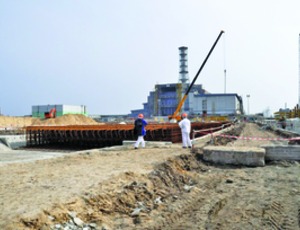While Japan struggles to stabilize its wrecked Fukushima nuclear plant, engineers in Ukraine are only now starting construction of a new enclosure for Chernobyl's fourth reactor, almost exactly 25 years after it exploded and caused immense human and environmental damage in the region and globally.

It's too early to say whether the Japanese will need their version of Chernobyl's $1.4-billion, 29,000-tonne steelwork safe enclosure to clear away their nuclear ruins. But the hard lessons learned in the development of Ukraine's $2.2-billion shelter implementation plan following the April, 26, 1986, disaster could give Japan's cleanup a running start.
Chernobyl's shelter implementation plan should have been completed a few years ago, according to tentative schedules made in the mid-1990s. Now, everybody's working toward a mid-2015 deadline for the new confinement to be in place.
But judging seemingly sluggish progress by conventional standards makes no sense, says Vince Novak, nuclear safety director at the European Bank for Reconstruction and Development, London, which manages the project's internationally raised fund.
The combination of nuclear hazards and engineering difficulties puts the Chernobyl project in a class of its own, Novak says. The preliminary early schedule was conditional on findings from subsequent research, he adds, some of which was in previously unknown terrain. “We got to the point where we could understand the scope [only] in the summer of 2003,” he says.
“[Even then,] procurement took longer than we anticipated in 2003, and the design of the new safe confinement took longer,” adds Novak. “The issues were first-of-a-kind for everybody,” he says. The involvement of national and international experts and regulators added further complications.
Finally, the new confinement's design is on course for securing regulatory approval, probably this autumn, says Eric Schmieman, senior technical adviser with the shelter implementation plan's project management unit. The unit includes Chernobyl staff and specialists from a consortium including San Francisco-based Bechtel National Inc. and Columbus, Ohio-based Battelle Memorial Institute.
With a span of 257 meters, the 150-m-long arching confinement will rise 105 meters to enclose the entire reactor building. The confinement will have a 100-year design life and accounts for two-thirds of the shelter plan's budget.
“Most of the preparatory works have been completed,” says Schmieman. Putting up a new vent stack over the reactor building next year, removing the old one in 2013 and strengthening walls in the turbine-generator hall next to the new confinement are among major pieces of work still to be done, he adds.
Earthmoving is largely done at the new confinement's erection site, just west of the reactor building. Piling is under way for the two large ground beams along which the turnkey consortium Novarka will slide into place the pre-assembled confinement. In preparation for the erection of the vault, concrete foundation pads are being cast for cranes.










Post a comment to this article
Report Abusive Comment